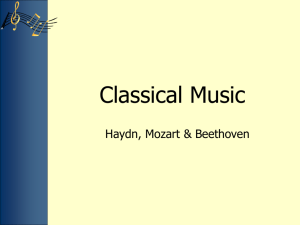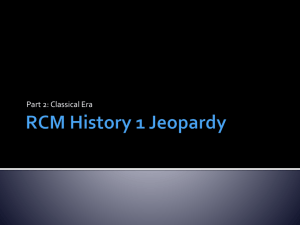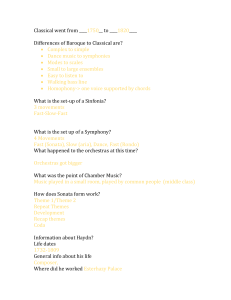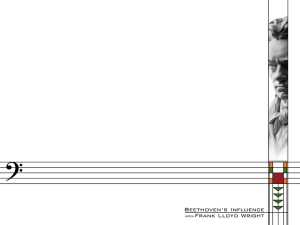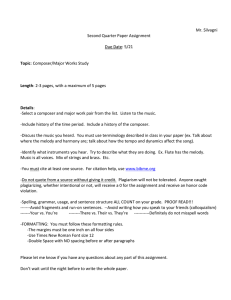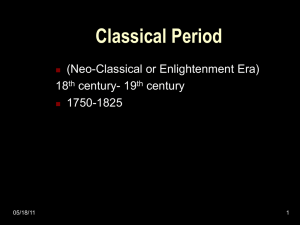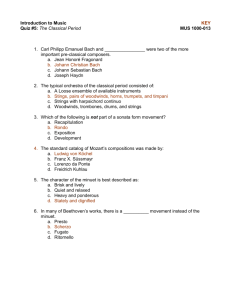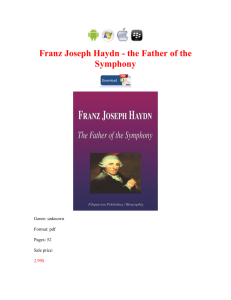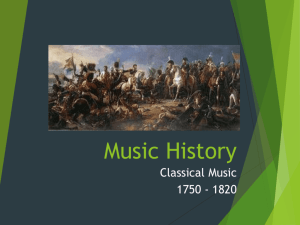ClassicalPeriod2012
advertisement
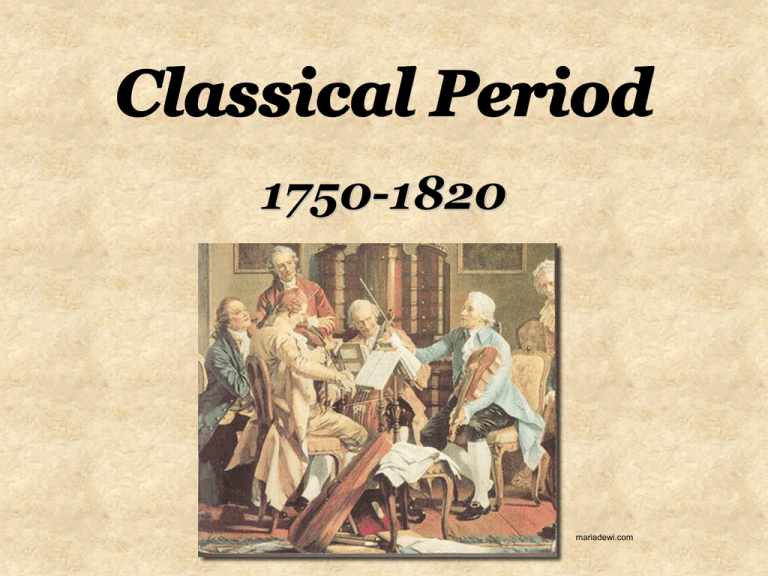
Classical Period 1750-1820 mariadewi.com Music of the Classical Period Unlike Baroque music that is fancy and ornamented, Classical music is simple and unornamented. cities.sulekha.com newworldencyclopedia.org Why the change? Classicism Simple lines and elegance of ancient Greeks and Romans were being used by artists, architects and composers Clearer division between parts Brighter contrasts and color Simplicity rather than complexity Melody rather than harmony important What makes it Classical? The best word to describe the Classical time period is BALANCE. The architecture, music, and art work was all symmetrical and balanced. Musical effects were removed and dramatic effects were diminished. The Parthenon Monticello The Oath of the Horatii by Jacques-Louis David Simple Music vs. Complex Music Minuet and Trio by Wolfgang Amadeus Mozart Simple Music vs. Complex Music Toccata and Fugue in D Minor by J. S. Bach The Pianoforte In 1709, the first pianoforte was developed by Christofori in Italy. By the end of the Classical period, many improvements had been made by Christofori as well as other craftsman, making it one of the most important developments of the period. wksu.org http://www.buzzgrimespi anos.com/page2.html Why was the Pianoforte Important? The pianoforte allowed the performer to create crescendos and diminuendos as well as being able to play loud and soft at the same time. pianoshoppersguide.co m Because the pianoforte allowed for more expression, ornamentation and improvisation were no longer needed. Music of the Classical Period Important forms of the Classical Period include… Symphony Sonata Sonatina Serenade musicnotes.com The Symphony The Classical symphony was developed in the 17th century. A symphony is a large, 4 movement work for an orchestra. The 1st movement is fast. The second movement is slow. The 3rd movement is a minuet or trio in #4time. The 4th movement is often very fast. The Sonata • The sonata is for a solo instrument and consists of four movements. • The 1st movement contains three sections. • The first section is the Exposition. In this section the theme is stated. The second section is the Development. In this section, the theme is altered or changed in some way. The third section is the Recapitulation. This section restates the original theme. The Sonatina • The sonatina is for a solo instrument and consists of four movements. • It is the same as the sonata but shorter in length. • The 1st movement contains three sections. • The first section is the Exposition. In this section the theme is stated. The second section is the Development. In this section, the theme is altered or changed in some way. The third section is the Recapitulation. This section restates the original theme. Serenades • An instrumental composition for a small ensemble intended for evening entertainment. • A love song sung in the evening below the beloved’s window. Europe thefastertimes.com Beethoven Haydn Classical.net Geology.com Mozart Classical.net Franz Joseph Haydn His Childhood Haydn was born in Austria in 1732. He lived until 1809. He was born into a musical family. At the age of 5, he was sent to live with and learn music from a relative who lived near Vienna. At the age of 8, he sang in the Vienna Boys’ Choir. He sang with the choir for nine years. last.fm mp3million.com St. Stephen’s Cathedral sacred-destinations.com Franz Joseph Haydn His Life Haydn was good friends with Mozart and a teacher of Beethoven! In 1790, he married Maria Anna Keller. It was an unhappy marriage. ramp.pdx.edu Franz Joseph Haydn Haydn was known to have a good sense of humor. muswrite.blogspot.com Once the prince made his orchestra stay 2 months longer than usual at his country home. Haydn composed “The Farewell Symphony.” One by one, the players got up and left the stage. Haydn had made his point and the next day, the prince allowed the orchestra to return home to their families. Symphony No. 45 by Haydn (1772) “Farewell Symphony” Franz Joseph Haydn In conjunction with his sense of humor, Haydn wrote the “Surprise” Symphony. The surprise comes in the second movement when there suddenly is a very loud chord. Haydn supposedly said that it “will make the women jump.” Actually it probably made men and women jump! Concerts in the 1790’s were very long and audience members tended to fall asleep. Symphony No. 94 by Haydn (1791) “The Surprise Symphony” Franz Joseph Haydn His Career Haydn supported himself by performing, teaching, playing the organ in church, and accompanying singers. At age 29, the wealthy Hungarian noble family by the name of Esterhazy, hired him as a Kapellmeister. http://en.wikipedia.org/wiki/Joseph_Haydn A Kapellmeister is a director of a choir or orchestra. The orchestra he conducted became known as one of the finest of the time. Franz Joseph Haydn His Career While visiting London 1790, Haydn would conduct a series of concerts featuring his symphonies. As a result, Oxford University awarded him an honorary doctorate of music. trutv.com In 1795, he would return to Austria and compose The Emperor’s Hymn. This music would become Austria’s national anthem. state.gov Franz Joseph Haydn His Music Haydn is credited with giving the symphony its modern form and structure. He is known as the “Father of the Symphony.” In all, he composed over 100 symphonies! naxos.co m He is known as the “Father of the String Quartet” A string quartet is a small group of four performers. It consists of two violins, one viola, and one cello. pulsd.com Haydn composed over 70 String Quartets! Serenade by Haydn Symphony No. 101 by Haydn (1795) “The Clock” Wolfgang Amadeus Mozart His Childhood Mozart was born in Salzburg, Austria in 1756. He lived until 1791. He began playing piano at the age of 3 and composed his first piece of music by the age of 5! spiritismtalk.blogspot.com Mozart and his sister Nannerl toured Europe as children and performed for Emperors, Kings, and Queens. Wolfgang Amadeus Mozart His Childhood His father, Leopold, was his only teacher. He taught him keyboard, mathematics, Latin, and German. When he was 6, his father took him to Vienna, where he performed for the emperor and was introduced as a child prodigy. A prodigy is a person who possesses exceptional qualities or abilities. During this time, Mozart taught himself to play the violin and the organ. thekidswindow.co.uk Wolfgang Amadeus Mozart His Childhood In 1770 when Mozart was 14 years old, he heard Miserere by Gregoris Allegri being sung at the Sistine Chapel. When he returned home, he wrote the entire piece of music from memory without error. mv.vatican.va Because of this amazing accomplishment, the Pope made him a Knight of the Golden Spur. mozartschildren.wordpress.com Wolfgang Amadeus Mozart His Life In 1782, at the age of 26, Mozart married Constanze Weber. He was good friends with Haydn. He composed six string quartets for Haydn and dedicated them to him in 1785. Mozart’s last years were filled with financial difficulties and health problems. http://en.wikipedia.org/wiki/ File:Costanze_Mozart_by_ Lange_1782.jpg oboeclassics.com Mozart died penniless and in debt. He was buried in a unmarked grave in the churchyard of St. Mark in Vienna. The exact location is unknown. findagrave.co m Wolfgang Amadeus Mozart His Music Mozart composed approximately 600 pieces of music! His first pieces of music were published in Paris when he was 7 years old. His early symphonies were influenced by Johann Christian Bach (J.S. Bach’s youngest son) whom he had met while visiting London when he was 8 years old. Classical.net While married to Constanze, he composed three of his most famous operas, Don Giovanni, The Marriage of Figaro, and The Magic Flute. Symphony No. 41 by Mozart (1788) “Jupiter” Piano Sonata No. 16 in C Major by Mozart (1788) “Dies Irae” from Requiem by Mozart Translation: Day of wrath, oh day of mourning, See fulfilled the prophet’s warning, Heaven and Earth in ashes burning. http://www.fanpop.com/spots/xmen/images/58093/title/nightcrawler-wallpaper X-Men United Why this song with this movie clip? 1. Wrath – Anger/Shooting 2. The prophet is Night Crawler 3. His warning is “Mutant Freedom Now” 4. If no freedom there will be War Eine Kleine Nachtmusik “A Little Night Music” by Mozart Ludwig van Beethoven His Childhood Beethoven was born in Bonn, Germany in 1770. He lived until 1827. He was born into a musical family. http://en.wikipedi a.org/wiki/File:Be ethoven_ house_of_birth_B onn_2008.jpg When he was 4 years old, his father began teaching him piano, violin, and composition. en.wikipedia.org Ludwig van Beethoven His Childhood By age 11, he was performing and sightreading with great expertise. His ability to improvise was compared to that of Mozart as a child prodigy. Improvise means to make music up on the spot. blog.mysanantonio.com In 1787, when he was 17, he met and played for Mozart while visiting Vienna. Mozart was impressed with Beethoven’s improvising skill. Ludwig van Beethoven In 1792, Beethoven met Haydn in Bonn, Germany. Haydn complimented Beethoven on some of his compositions. This impressed the elector who then sent Beethoven to Vienna to study with Haydn. An elector is a prince or In 1792, Beethoven moved to Vienna where he nobleman. spent the rest of his life. blog.mysanantonio.co m Ludwig van Beethoven He started losing his hearing in 1800 and by 1820 he was no longer able to conduct an orchestra. However, he still composed music, including his famous Symphony No. 9. beethoven.ws spanishdict.co m He was completely deaf the last 7 years of his life. Ludwig van Beethoven His Music His music is divided into three periods: Early, Middle and Late. The Early period lasted until about 1802 and was strongly influenced by the works of Haydn and Mozart. Works from the Early period include… Symphony No. 1 Symphony No. 2 12 Piano Sonatas including “Pathetique” musical-lectures.com Piano Sonata No. 8 “Pathetique” by Beethoven platypuscomix.net “Somewhere Out There” imdb.com Ludwig van Beethoven His Music The Middle period lasted from 1803 to 1814. His works included themes of heroism and struggle. favorite-classical-composers.com Works from the Middle period include… Symphonies No. 3 through No. 8 Piano Sonatas including “Moonlight,” “Waldstein’” and “Appassionata” Fidelio - his only opera beta.wosu.org Piano Sonata No. 14 “Moonlight Sonata” by Beethoven Symphony No. 3 “Eroica” by Beethoven Beethoven composed this symphony in admiration of Napoleon Bonaparte. Symphony No. 5 by Beethoven The “Symphony of Destiny.” Beethoven described the beginning four notes as, “That’s how fate knocks on your door.” Ludwig van Beethoven His Music The Late period lasted from 1815 onward. His works were characterized by deep, personal expression. Works from the Late period include… Symphony No. 9 Last five piano sonatas Missa Solemnis lasvegassun.com Symphony No. 9 by Beethoven “The Symphony of Joy” Based upon the poem, “Ode to Joy” by Friedrich Schiller. Practice Listening Test You will hear each song two times. You need to write the ENTIRE title. SPELLING COUNTS! Listening 1 by Beethoven Symphony No. 5 “The Symphony of Des Listening 2 by Mozart Piano Sonata No. 16 in C Major Listening 3 by Beethoven Piano Sonata No. 8 “Pathetique” Listening 4 by Haydn Serenade Listening 5 by Mozart Eine Kleine Nachtmusik “A Little Night Music” Listening 6 by Haydn Symphony No. 94 The “Surprise” Symphony Listening 7 by Mozart “Dies Irae” from Requiem Listening 8 by Beethoven Piano Sonata No. 14 “Moonlight Sonata” Listening 9 by Haydn Symphony No. 101 “The Clock” Listening 10 by Beethoven Symphony No. 3 “Eroica” Listening 11 by Mozart Symphony No. 41 “Jupiter” Listening 12 by Beethoven Symphony No. 9 “The Symphony of Joy”
